La Belle Noiseuse (Jacques Rivette) 1991
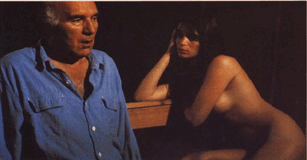 By methodically examining the rigors and contemplation that
go into creating great art, French New Wave master Jacques Rivette, has created
something of a masterpiece himself in La Belle Noiseuse. The film begins
unassumingly in a hotel courtyard where we see a young man stealthily sketching
some seemingly oblivious English-speaking tourists. As Rivette’s camera
continues to pan, however, we find that our casual artist is actually the
subject of another’s art. A woman on the hotel’s balcony furtively snaps a
photo of him, but is noticed by sketcher, who becomes visibly irate. As soon as
he confronts her, though, it becomes immediately apparent to us that most of
this incident was a ruse. The two artists are lovers, and their coyness was
entirely put on. Spurned by the excitement of their charade, they retire to the
bedroom. The stunt even continues a bit farther than planned when one of the
tourists watching this amorous French drama unfold says to another in mock
culture shock, “Well, what do you expect?” This seemingly frivolous episode
resonates throughout the rest of the film, since it manages to say much about
the relationship between an artist and subject, the secretive, similar natures
of art and love, and the need to sometimes create an environment where
ever-fleeting inspiration might strike. It’s these themes that come to the
fore during rest of the long journey that La Belle Noiseuse takes.
By methodically examining the rigors and contemplation that
go into creating great art, French New Wave master Jacques Rivette, has created
something of a masterpiece himself in La Belle Noiseuse. The film begins
unassumingly in a hotel courtyard where we see a young man stealthily sketching
some seemingly oblivious English-speaking tourists. As Rivette’s camera
continues to pan, however, we find that our casual artist is actually the
subject of another’s art. A woman on the hotel’s balcony furtively snaps a
photo of him, but is noticed by sketcher, who becomes visibly irate. As soon as
he confronts her, though, it becomes immediately apparent to us that most of
this incident was a ruse. The two artists are lovers, and their coyness was
entirely put on. Spurned by the excitement of their charade, they retire to the
bedroom. The stunt even continues a bit farther than planned when one of the
tourists watching this amorous French drama unfold says to another in mock
culture shock, “Well, what do you expect?” This seemingly frivolous episode
resonates throughout the rest of the film, since it manages to say much about
the relationship between an artist and subject, the secretive, similar natures
of art and love, and the need to sometimes create an environment where
ever-fleeting inspiration might strike. It’s these themes that come to the
fore during rest of the long journey that La Belle Noiseuse takes.
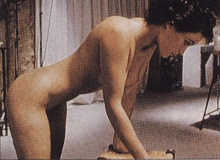 The vast majority of La
Belle Noiseuse takes place in and around the estate of Frenhofer (Michel
Piccoli), a recluse master painter who brings an end to his ten year hiatus from
his art near the film’s beginning. What makes it exceptional, and probably the
best film ever to examine a painter, is that we are privy to every step of his
rebirth. Over four long hours, Rivette examines each aspect of his creative
progression, from the most inane physical logistics to the fleeting moments of
inspiration that power the artist through his rough spots. The first instance of
stimulation that Frenhofer’s muse Marianne (Emmanuelle Béart) provides is
clearly one of the film’s highlights. A brief shot of Marianne as she’s
leaving the artist’s studio is all that it takes to end his inventive
impotence, and somehow, without anything explicitly telling us, Béart, Piccoli,
and Rivette get us to understand how important this short-lived image is.
Something about the instant triggers an unmistakable response in the artist and
audience. There’s a tiny change in her posture (she becomes slightly less
guarded in how she carries herself) that obviously piques Frenhofer’s
interest, and Rivette frames the shot so she’s placed in the center of the
frame. It’s so subtle that some of the audience might not even notice it, but
for those who do, they become fueled by that holy moment as if they were the
artist themselves. Its existence proves to us that there’s something there for
Frenhofer to chase after, and the rest of the film pursues it furiously in an
attempt to recreate it. There’s considerable suspense generated by our fears
that this image and the mood surrounding it might not be reproducible by force.
The vast majority of La
Belle Noiseuse takes place in and around the estate of Frenhofer (Michel
Piccoli), a recluse master painter who brings an end to his ten year hiatus from
his art near the film’s beginning. What makes it exceptional, and probably the
best film ever to examine a painter, is that we are privy to every step of his
rebirth. Over four long hours, Rivette examines each aspect of his creative
progression, from the most inane physical logistics to the fleeting moments of
inspiration that power the artist through his rough spots. The first instance of
stimulation that Frenhofer’s muse Marianne (Emmanuelle Béart) provides is
clearly one of the film’s highlights. A brief shot of Marianne as she’s
leaving the artist’s studio is all that it takes to end his inventive
impotence, and somehow, without anything explicitly telling us, Béart, Piccoli,
and Rivette get us to understand how important this short-lived image is.
Something about the instant triggers an unmistakable response in the artist and
audience. There’s a tiny change in her posture (she becomes slightly less
guarded in how she carries herself) that obviously piques Frenhofer’s
interest, and Rivette frames the shot so she’s placed in the center of the
frame. It’s so subtle that some of the audience might not even notice it, but
for those who do, they become fueled by that holy moment as if they were the
artist themselves. Its existence proves to us that there’s something there for
Frenhofer to chase after, and the rest of the film pursues it furiously in an
attempt to recreate it. There’s considerable suspense generated by our fears
that this image and the mood surrounding it might not be reproducible by force.
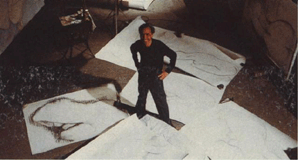 We spend much of the movie watching Frenhofer as he
sketches, poses Marianne, talks about his attempts to push himself further, and
complains about his personal and professional stagnancy, but it’s all really
just a ploy to fill time as he works toward achieving his stubborn idea.
Watching him as he prepares his environment we’re as exasperated and impatient
as Marianne is as she models for him. Rivette reveals himself as a filmic sadist
here, but one with a reason for punishing us. We need to be frustrated by the
failures and overjoyed by the successes of the artistic process, and he realizes
that the only way for us to have a truly comprehensive understanding of the
process is to see everything involved in that process, even when it isn’t
thrilling or encouraging. The detail that Rivette shows us in each moment is at
once exasperating and exciting. We’re aware of the dust from the pastel, the
physical presence of the paper, and the ache in the model’s back. It’s
fascinating, even as it tries the audience’s patience, and a feeling hangs
over the movie telling us that even though we’re not able to escape the
confines of his studio, we’re on the cusp of a revelation that will reward us
for staying. The extreme length of La
Belle Noiseuse becomes necessary since it stretches its audience closer to
the breaking point that Frenhofer and Marianne are moving toward. It’s not
coincidental that the film’s intermission is a mere five minutes long. To
allow any more of an escape might erode the feeling of exhilarating oppression
that he works so hard to build, and to further reinforce this mood, upon
returning to the theater, the audience is greeted with an impatiently delivered
question: “Can we continue?” Seeing the film in a theater is crucial,
because the darkened movie theater (hopefully) doesn’t provide the same
distractions that can crop up at home. The focused intensity that a viewer’s
relationship with a movie screen can create is absolutely necessary here since
it approximates the film’s central relationship.
We spend much of the movie watching Frenhofer as he
sketches, poses Marianne, talks about his attempts to push himself further, and
complains about his personal and professional stagnancy, but it’s all really
just a ploy to fill time as he works toward achieving his stubborn idea.
Watching him as he prepares his environment we’re as exasperated and impatient
as Marianne is as she models for him. Rivette reveals himself as a filmic sadist
here, but one with a reason for punishing us. We need to be frustrated by the
failures and overjoyed by the successes of the artistic process, and he realizes
that the only way for us to have a truly comprehensive understanding of the
process is to see everything involved in that process, even when it isn’t
thrilling or encouraging. The detail that Rivette shows us in each moment is at
once exasperating and exciting. We’re aware of the dust from the pastel, the
physical presence of the paper, and the ache in the model’s back. It’s
fascinating, even as it tries the audience’s patience, and a feeling hangs
over the movie telling us that even though we’re not able to escape the
confines of his studio, we’re on the cusp of a revelation that will reward us
for staying. The extreme length of La
Belle Noiseuse becomes necessary since it stretches its audience closer to
the breaking point that Frenhofer and Marianne are moving toward. It’s not
coincidental that the film’s intermission is a mere five minutes long. To
allow any more of an escape might erode the feeling of exhilarating oppression
that he works so hard to build, and to further reinforce this mood, upon
returning to the theater, the audience is greeted with an impatiently delivered
question: “Can we continue?” Seeing the film in a theater is crucial,
because the darkened movie theater (hopefully) doesn’t provide the same
distractions that can crop up at home. The focused intensity that a viewer’s
relationship with a movie screen can create is absolutely necessary here since
it approximates the film’s central relationship.
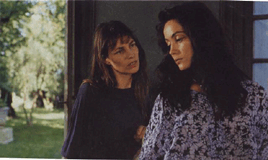 The long, formalist tracking shots, the abundance of
dialogue, and Rivette’s tendency to often put the action behind a doorway’s
proscenium arch give the film a slightly stagy feel, but the movie is undeniably
cinematic. It’s doubtful that any other medium could capture the physically
and mentally arduous process of creating art so well, since the progression from
blank page to finished sketch can be shown in real time in film. Better yet,
these scenes have an inherent narrative progression as they push closer to a
fully formed idea. All the while, the relationship here between the model and
the artist intensifies. The most difficult and most rewarding thing about trying
to capture a subject’s life in a painting, it seems, is having to deal with
that living, breathing, critical, and supportive subject. Just as the painter
and his model grow tired and unaware of Marianne’s nudity, so does the
audience (which is shocking, since it’s so unmistakably present in the early
scenes). The same learned unawareness applies to the actors themselves. The cast
is universally brilliant here, and Piccoli and Béart dissolve into their roles
here in a way that few performances can match. As Frenhofer’s studio becomes a
metaphorical playground, they become archetypes for artist and subject, man and
woman, and inspiration and frustration. They battle wills as they strive toward
a common goal, and have what must be at once the most intimate of relationships
and the most impersonal. Though Marianne is often naked in the studio, that
nudity almost always feels professional. The artist says that he can’t
remember most of his past models, but he’s married one of them. His wife is at
once jealous of the new model and proud to have come first. The women both talk
of their time spent in the studio, where they lose all sense of time and self,
as a remarkable, romantic achievement.
The long, formalist tracking shots, the abundance of
dialogue, and Rivette’s tendency to often put the action behind a doorway’s
proscenium arch give the film a slightly stagy feel, but the movie is undeniably
cinematic. It’s doubtful that any other medium could capture the physically
and mentally arduous process of creating art so well, since the progression from
blank page to finished sketch can be shown in real time in film. Better yet,
these scenes have an inherent narrative progression as they push closer to a
fully formed idea. All the while, the relationship here between the model and
the artist intensifies. The most difficult and most rewarding thing about trying
to capture a subject’s life in a painting, it seems, is having to deal with
that living, breathing, critical, and supportive subject. Just as the painter
and his model grow tired and unaware of Marianne’s nudity, so does the
audience (which is shocking, since it’s so unmistakably present in the early
scenes). The same learned unawareness applies to the actors themselves. The cast
is universally brilliant here, and Piccoli and Béart dissolve into their roles
here in a way that few performances can match. As Frenhofer’s studio becomes a
metaphorical playground, they become archetypes for artist and subject, man and
woman, and inspiration and frustration. They battle wills as they strive toward
a common goal, and have what must be at once the most intimate of relationships
and the most impersonal. Though Marianne is often naked in the studio, that
nudity almost always feels professional. The artist says that he can’t
remember most of his past models, but he’s married one of them. His wife is at
once jealous of the new model and proud to have come first. The women both talk
of their time spent in the studio, where they lose all sense of time and self,
as a remarkable, romantic achievement.
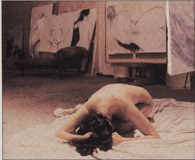 Though the film seems to be working toward an inevitable
end, it surprises with the complexity with which it reaches that ending. By the
time we’ve worked alongside Frenhofer and Marianne for four hours, we
understand much about what makes them tick. Though we never really see
Frenhofer’s finished product, we come to understand he’s succeeded
unequivocally anyway. When Marianne sees her reinterpreted visage, it stuns her
into silence. To immortalize her, Frenhofer had to capture her life force, and
when faced with her unmistakable mortality, its inanimate presence reminds
Marianne of her inescapable death. The moment at once expands and reduces
Marianne, and the effects that the painting has on her are equal to those it has
on the artist. With such affirmation of success, seeing the actual finished
painting becomes unnecessary, especially since our own imaginations might do a
job more suited to us. Frenhofer, like Rivette, understands the ability of great
art to create a shift in one’s perception of the world, and even oneself.
Certainly, the time spent in Frenhofer’s studio during La Belle Noiseuse comes with its challenges, but it also offers an
undeniable opportunity for the film’s audience to alter how they think about
the possibilities of film and art.
Though the film seems to be working toward an inevitable
end, it surprises with the complexity with which it reaches that ending. By the
time we’ve worked alongside Frenhofer and Marianne for four hours, we
understand much about what makes them tick. Though we never really see
Frenhofer’s finished product, we come to understand he’s succeeded
unequivocally anyway. When Marianne sees her reinterpreted visage, it stuns her
into silence. To immortalize her, Frenhofer had to capture her life force, and
when faced with her unmistakable mortality, its inanimate presence reminds
Marianne of her inescapable death. The moment at once expands and reduces
Marianne, and the effects that the painting has on her are equal to those it has
on the artist. With such affirmation of success, seeing the actual finished
painting becomes unnecessary, especially since our own imaginations might do a
job more suited to us. Frenhofer, like Rivette, understands the ability of great
art to create a shift in one’s perception of the world, and even oneself.
Certainly, the time spent in Frenhofer’s studio during La Belle Noiseuse comes with its challenges, but it also offers an
undeniable opportunity for the film’s audience to alter how they think about
the possibilities of film and art.
* * * * Masterpiece
06-27-02
Jeremy Heilman